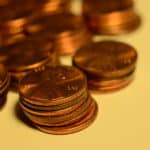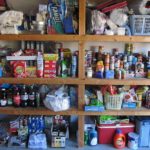
Have you done your coronavirus panic buying yet?
Shoppers across the country – and, indeed, around the world – have been reporting packed stores and empty shelves, as people apparently spent the weekend stocking up for what they fear could be a coronavirus emergency. “I have never in my life seen Seattle Costco lines like this – 40 carts deep with over one-hour wait times,” one Twitter user wrote on Saturday (while sharing the above photo). “Water, toilet paper, rice, meat – all are disappearing fast,” another tweeted. “I just bought an additional year’s worth of food last night,” a third Twitter user announced.
Other non-grocery items like face masks are already getting hard to find – and expensive. CVS, the nation’s largest drug store chain, is already warning of potential short-term shortages of items like hand sanitizers and cleaning wipes.
Stocking up all at once is a big undertaking, not to mention an expensive one. So if you’ve ever been judged for using coupons and shopping the sales in order to amass a stockpile of discounted food and household products in your home, you’re going to be looking pretty smart when everyone else’s supplies, and funds, start running low.
But will you be calmly clipping coupons and looking for deals when it’s time to get serious about prepping for doomsday? Saving money can be a hard habit to break, even if society is collapsing around you and money itself has become meaningless.
It’s way too early to panic, of course, about the potential impact of the coronavirus. But it doesn’t hurt to be prepared. So if your stockpile is a little lacking, there are things you can do now to get ready for the unexpected, without breaking the bank.
Firstly, “panic buying isn’t helpful,” infectious disease researcher Emma Hodcroft advised on Twitter. “Pick up a little extra now in every shop you do, and this is easily absorbed by the system. Buy every can of beans in one go, and you’ve stressed the system early before there was any need. Stay calm, stay rational.”
If you don’t want to brave the stores, you could always buy everything at once from the comfort of your home. But unless you’re a hardcore doomsday prepper with a bunker in your basement and a cache of weapons at the ready, experts on emergency preparedness suggest saving yourself a few thousand dollars and skipping the giant pallets of emergency survival food. Everyone from Costco to Sam’s Club to various online retailers sells an assortment of hundreds of cans containing tens of thousands of servings of freeze-dried and dehydrated food, designed to last you and your family for a full year.
One such pallet contains 30,144 servings for $4,000, which comes out to about 13 cents a meal. Not a bad deal – if you actually end up using it. If you don’t, four grand could be a high price to pay for some peace of mind. Not to mention that if the world is in such rough shape that the food supply is in complete disarray for an entire year, you’ll probably be faced with more problems than just deciding what to eat that day.
Most experts advise having a more realistic nonperishable food supply good for anywhere from three days to two weeks to as long as 90 days in extreme situations, just in case there’s a temporary disruption in the food distribution system, or if you’re confined to your home for a while. And they don’t mean a supply of freeze-dried survival food, but everyday edibles that your family will actually eat.
Charles Macurdy, formerly of the Vancouver Observer, is a former chef and an apocalypse enthusiast – which could prove to be a handy combination in the event of an emergency. He once offered some unique but helpful culinary hints when prepping for disaster. “Practice recipes with a small number of rarely-used grocery items. This way, you will have a few tricks on hand when such items are all that is left,” he advises.
For instance, he offers up a quick-and-easy recipe for DIY mac and cheese, featuring a can of condensed cheddar cheese soup, a can of cream of celery soup and cooked pasta. Just stir, heat and eat. When grocery supplies get low and everyone else rushes to the store to fight over the last box of Kraft, you can head to the soup aisle. Would the average person think to grab cream of celery soup, of all things? “That is literally nobody’s plan. Did you even know that cheddar cheese soup came in a can?” he asks.
Look for sales and coupons on items like these, and slowly start building your stockpile of things that no one in your house might be tempted to eat unless you really had to.
And the next time you’re in the grocery store, familiarize yourself with what’s on the bottom shelves. “These are the less popular items,” Macurdy points out, which means they will likely be the last ones to go when people start panic buying. “If you can cook with those, you should be fine for a while.”
A 2014 survey by the coupon code site Tada found that most respondents preparing for disaster were well-stocked with flashlights, first aid kids, batteries and water. Extra food was only fifth on the list of must-haves, slightly ahead of weapons, cash, gasoline and a stash of precious metals in case no one will take your cash.
So these people may be prepared, if hungry. But it’s a good reminder that you should consider stocking up on more than just food in the event of an emergency. You’ll need water, first aid supplies, and household items like soap, detergent, toothpaste, toilet paper and feminine hygiene products – just the kinds of items that are most prominently featured in most couponers’ stockpiles. So if your supplies are getting low, you should start looking for deals now while you can.
So whether or not you think the coronavirus is an imminent threat, now might be a good time to take stock of your preparedness efforts, for this or any other potential disaster. Just do so calmly, and don’t panic. At least not yet.
Image source: Twitter/@KristinaMMoy










